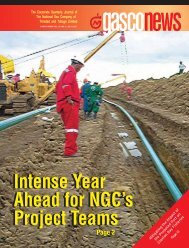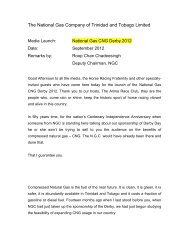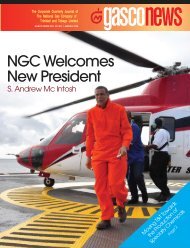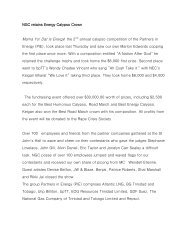June 2012 ISSN 2070-4593 - NGC
June 2012 ISSN 2070-4593 - NGC
June 2012 ISSN 2070-4593 - NGC
You also want an ePaper? Increase the reach of your titles
YUMPU automatically turns print PDFs into web optimized ePapers that Google loves.
China Leads Growth in Global<br />
Wind Power Capacity<br />
Global installed wind power capacity<br />
continued to grow in 2011, albeit at a slightly<br />
lower rate than in 2009 and 2010, according<br />
to new research conducted by the Worldwatch<br />
Institute for its Vital Signs Online service.<br />
The world now has approximately four<br />
times the installed wind capacity that it did<br />
in 2005, reflecting the combined effects<br />
of falling prices, improved technology,<br />
global investment, and various incentive<br />
programs.<br />
China led the way with a 43 percent share<br />
of global capacity additions in 2011, followed<br />
by the United States at 17 percent, India with<br />
almost 7 percent, and Germany at 5 percent,<br />
writes report author and Worldwatch’s<br />
Climate and Energy Program Manager Mark<br />
Konold.<br />
“China continues to lead the world in<br />
wind capacity additions, having increased<br />
its capacity a remarkable 40 percent since<br />
2010,” said Konold. “But a gap remains<br />
between this installed capacity and the<br />
amount of wind power that is actually<br />
available for use in the country. Because of<br />
grid connection challenges and other issues,<br />
China is struggling to use all of the electricity<br />
generated by its turbines.”<br />
Despite large increases in installed wind<br />
power capacity, several Chinese provinces,<br />
including Inner Mongolia and Gansu, have<br />
actually lost a significant portion of their<br />
generation capacity because of technical<br />
problems. Over the next five years, China<br />
plans to invest more than US$400 billion<br />
to make improvements to its electrical grid<br />
that will enable it to fully integrate its total<br />
installed wind capacity by 2015.<br />
In 2011, the United States accounted<br />
for approximately 17 percent of global wind<br />
power capacity additions. Although the<br />
country generated 27 percent more electricity<br />
from wind in 2011 than in 2010, wind power<br />
still accounts for less than 3 percent of total<br />
U.S. power generation, according to the<br />
report.<br />
Konold credits much of the growth in<br />
U.S. wind power capacity to the federal<br />
Production Tax Credit (PTC), which helped to<br />
finance approximately 4,000 megawatts of<br />
new capacity by reducing corporate income<br />
tax by 2.2 cents for every kilowatt-hour<br />
produced.<br />
The report also discusses wind power<br />
developments in the European Union, where<br />
Germany regained its position as regional<br />
leader for installed capacity. Currently,<br />
wind accounts for almost 8 percent of the<br />
country’s electricity consumption. Although<br />
Spain added only a third of total EU capacity<br />
since 2008, wind power accounts for almost<br />
16 percent of the country’s electricity<br />
consumption. Economic instability has had<br />
some negative impacts on European wind<br />
power, however, pushing future growth<br />
projections down and potentially hampering<br />
investment.<br />
Worldwide, wind power prices fell to<br />
$1.2 million per megawatt in the first half<br />
of 2011, mainly because of improvements<br />
in supply chain efficiency and economies<br />
of scale. Competition from Chinese<br />
manufacturers and their excess capacity to<br />
build machines and flood the market also<br />
played a role. In addition, the capacity factor<br />
of wind turbines (the ratio of actual output<br />
to nameplate capacity) continues to rise as<br />
better technologies enter the market, further<br />
driving down turbine costs. Combined, these<br />
factors are expected to bring down the cost<br />
of wind energy 12 percent by 2016, making<br />
onshore wind cost competitive with coal,<br />
gas, and nuclear power.<br />
<strong>June</strong> <strong>2012</strong> Earth Conscious 39









